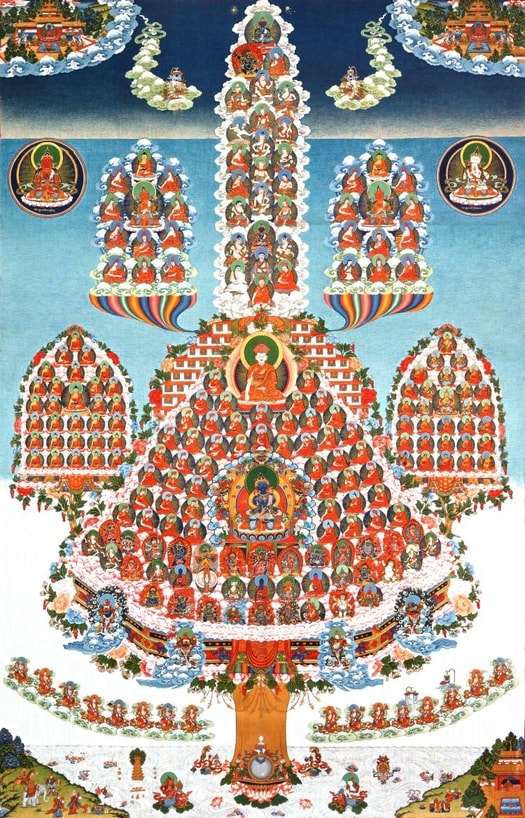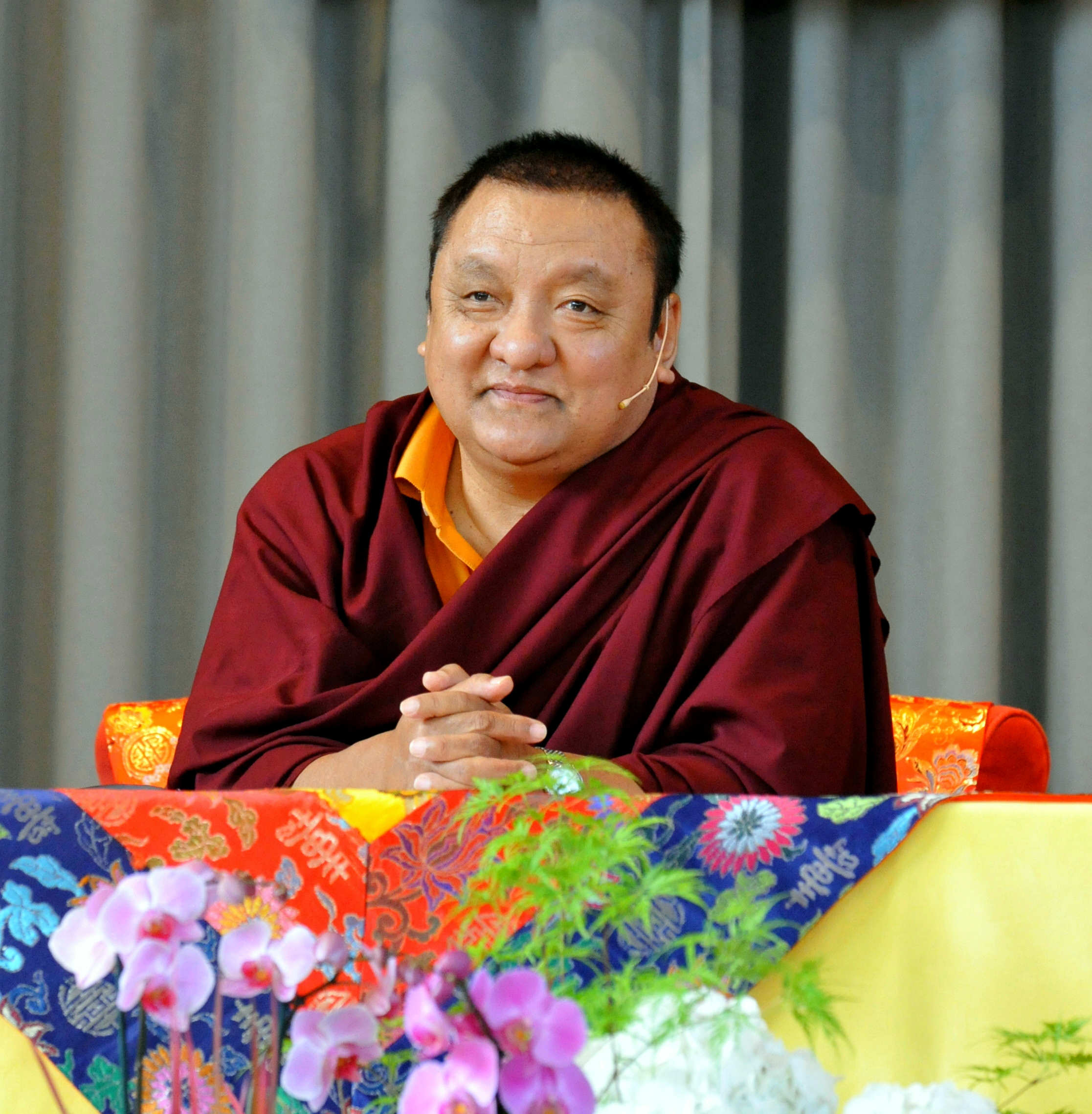|
Drikungpa
The Drikungpa, or more formally the Drikung Kyabgön, is the head of the Drikung Kagyu, a sub-school of the Kagyu (བཀའ་བརྒྱུད, ), itself one of the four major schools of Tibetan Buddhism. Like all other Kagyu lineages, origins of Drikung Kagyu can be traced back to the Great Indian Master Tilopa who passed on his teachings to Mahasiddha Naropa who lived around 10th and 11th century. The founder of the Drikung Kagyu lineage was Jigten Sumgön (1143-1217) of the Kyura clan, who was the disciple of Phagmo Drupa. According to historical account from the time, Jigten Sumgön's teachings attracted more than 100,000 people at a time, with the highest number of attendance recorded at 130,000. From the founding of Drikung Thil Monastery in 1179 to the present day, the Drikung Kagyu lineage has been led by a succession of spiritual heads ("throne-holders"). One of the two current heads of the lineage, Drikung Kyabgön Chetsang Rinpoche, Könchok Tenzin Kunzang Thinley L ... [...More Info...] [...Related Items...] OR: [Wikipedia] [Google] [Baidu] |
Drikung Kagyu Tulkus
Drikung Kagyü or Drigung Kagyü ( Wylie: 'bri-gung bka'-brgyud) is one of the eight "minor" lineages of the Kagyu school of Tibetan Buddhism. "Major" here refers to those Kagyü lineages founded by the immediate disciples of Gampopa (1079-1153) while "minor" refers to all the lineages founded by disciples of Gampopa's main disciple, Phagmo Drupa (1110-1170). One of these disciples, Jigten Sumgön (1143-1217), is the founder of Drikung. History Like with all other Kagyu lineages, origins of Drikung Kagyü can be traced back to the Great Indian Master Tilopa who passed on his teachings to Mahasiddha Naropa who lived around 10th and 11th century. The founder of the Drikung Kagyü lineage was Jigten Sumgön (1143-1217) of the Kyura clan, who was the disciple of Phagmo Drupa. According to historical account from the time, Jigten Sumgön's teachings attracted more than 100,000 people at a time, with the highest number of attendance recorded at 130,000. Several sub-schools branche ... [...More Info...] [...Related Items...] OR: [Wikipedia] [Google] [Baidu] |
Jigten Sumgön
Jigten Sumgön or Jigten Gönpo འཇིག་རྟེན་གསུམ་མགོན (1143–1217) was the founder of the Drikung Kagyu lineage and main disciple of Phagmo Drupa. He founded Drikung Thil Monastery in 1179. Jigten Sumgön and the Drikung lineage are best known for the set of teachings known as The Five Profound Paths of Mahāmudrā (phyag chen lnga ldan). Some of Jigten Sumgön's sayings were collected by Sherab Jungne into what is known as the '' Drikung Gongchig'' (Wylie transliteration: ''dgongs gcig'', "the single intention"), a profound philosophical compendium that further developed in commentarial works written in following generations. Some of Jigten Sumgön's teachings were collected by another disciple into what is known as ''The Heart of the Great Vehicle's Teachings'' (''theg chen bstan pa'i snying po''). Life The meaning of Jigten Sumgön ('''jig rten gsum mgon'') is "The Lord of the Triple World". Jigten Sumgön is known under various names: ... [...More Info...] [...Related Items...] OR: [Wikipedia] [Google] [Baidu] |
Karmapa
The Karmapa (honorific title ''His Holiness the Gyalwa'' ��ྒྱལ་བ་, Victorious One''Karmapa'', more formally as ''Gyalwang'' ��ྒྱལ་དབང་ཀརྨ་པ་, King of Victorious Ones''Karmapa'', and informally as the ''Karmapa Lama'') is the head of the Karma Kagyu, the largest sub-school of the Kagyu (བཀའ་བརྒྱུད, ), itself one of the four major schools of Tibetan Buddhism. Karmapa was Tibet's first consciously incarnating lama. The historical seat of the Karmapas is Tsurphu Monastery in the Tolung valley of Tibet. The Karmapa's principal seat in exile is the Dharma Chakra Centre at Rumtek Monastery in Sikkim, India. His regional monastic seats are Karma Triyana Dharmachakra in New York and Dhagpo Kagyu Ling in Dordogne, France. Due to a controversy within the Karma Kagyu school over the recognition process, the identity of the current 17th Karmapa is disputed by some. See Karmapa controversy for details. Origin of the line ... [...More Info...] [...Related Items...] OR: [Wikipedia] [Google] [Baidu] |
Shamarpa
The Shamarpa (; literally, "Person (i.e. Holder) of the Red Crown"), also known as ''Shamar Rinpoche'', or more formally Künzig Shamar Rinpoche, is a lineage holder of the Karma Kagyu school of Tibetan Buddhism and is regarded to be the mind manifestation of Amitābha. He is traditionally associated with Yangpachen Monastery near Lhasa. The first Shamarpa, Drakpa Senggé (, 1283–1349), received the title "Shamarpa", and a red crown, an exact replica of Karmapa’s black crown from Rangjung Dorje, 3rd Karmapa, establishing the second line of reincarnate lamas in Tibetan Buddhism. The Karmapa was the first. The Shamarpa is often referred to as the "Red Hat Karmapa", especially in early Kagyu texts. The 5th Dalai Lama saw the Shamarpa as equal to the Karmapa: The Shamarpa lineage Shamarpa considered to be successive reincarnations are listed in "The Garland of Moon Water Crystal" by the 8th Tai Situpa Chökyi Jungne and Belo Tsewang Künkhyab. # Khedrup Drakpa Senge ... [...More Info...] [...Related Items...] OR: [Wikipedia] [Google] [Baidu] |
Kagyu
The ''Kagyu'' school, also transliterated as ''Kagyü'', or ''Kagyud'' (), which translates to "Oral Lineage" or "Whispered Transmission" school, is one of the main schools (''chos lugs'') of Tibetan (or Himalayan) Buddhism. The Kagyu lineages trace themselves back to the 11th century Indian Mahasiddhas Naropa, Maitripa and the yogini Niguma, via their student Marpa Lotsawa (1012–1097), who brought their teachings to Tibet. Marpa's student Milarepa was also an influential poet and teacher. The Tibetan Kagyu tradition gave rise to a large number of independent sub-schools and lineages. The principal Kagyu lineages existing today as independent schools are those which stem from Milarepa's disciple, Gampopa (1079–1153), a monk who merged the Kagyu lineage with the Kadam tradition. The Kagyu schools which survive as independent institutions are mainly the Karma Kagyu, Drikung Kagyu, Drukpa Lineage and the Taklung Kagyu. The Karma Kagyu school is the largest of the ... [...More Info...] [...Related Items...] OR: [Wikipedia] [Google] [Baidu] |
Tibetan Buddhism
Tibetan Buddhism (also referred to as Indo-Tibetan Buddhism, Lamaism, Lamaistic Buddhism, Himalayan Buddhism, and Northern Buddhism) is the form of Buddhism practiced in Tibet and Bhutan, where it is the dominant religion. It is also in majority regions surrounding the Himalayan areas of India (such as Ladakh, Sikkim, Arunachal Pradesh, and a minority in Himachal Pradesh and Uttarakhand), in much of Central Asia, in the southern Siberian regions such as Tuva, and in Mongolia. Tibetan Buddhism evolved as a form of Mahāyāna Buddhism stemming from the latest stages of Indian Buddhism (which also included many Vajrayāna elements). It thus preserves many Indian Buddhist tantric practices of the post-Gupta early medieval period (500 to 1200 CE), along with numerous native Tibetan developments. In the pre-modern era, Tibetan Buddhism spread outside of Tibet primarily due to the influence of the Mongol Yuan dynasty (1271–1368), founded by Kublai Khan, which had rul ... [...More Info...] [...Related Items...] OR: [Wikipedia] [Google] [Baidu] |
Tilopa
Tilopa (Prakrit; Sanskrit: Talika or Tilopadā; 988–1069) was an Indian Buddhist monk in the tantric Kagyu lineage of Tibetan Buddhism. He lived along the Ganges River, with wild ladies as a tantric practitioner and mahasiddha. He practiced Anuttarayoga Tantra, a set of spiritual practices intended to accelerate the process of attaining Buddhahood. He became a holder of all the tantric lineages, possibly the only person in his day to do so. As well as the way of insight, and Mahamudra he learned and passed on the Way of Methods, today known as the 6 Yogas of Naropa, and guru yoga. Naropa is considered his main student. Life Tilopa was born into the priestly caste – according to some sources, a royal family – but he adopted the monastic life upon receiving orders from a dakini (female buddha whose activity is to inspire practitioners) who told him to adopt a mendicant and itinerant existence. From the beginning, she made it clear to Tilopa that his real parents wer ... [...More Info...] [...Related Items...] OR: [Wikipedia] [Google] [Baidu] |
Naropa
Nāropā ( Prakrit; sa, Nāropāda, Naḍapāda or Abhayakirti) or Abhayakirti was an Indian Buddhist Mahasiddha. He was the disciple of Tilopa and brother, or some sources say partner and pupil, of Niguma. As an Indian Mahasiddha, Naropa's instructions inform Vajrayana, particularly his six yogas of Naropa relevant to the completion stage of anuttarayogatantra. He was also one of the gatekeepers of Vikramashila monastery which is located in Bihar. Although some accounts relate that Naropa was the personal teacher of Marpa Lotsawa, other accounts suggest that Marpa held Naropa's lineage through intermediary disciples only. Names According to scholar John Newman, "the Tibetans give Nāro's name as ''Nā ro pa, Nā ro paṇ chen, Nā ro ta pa,'' and so forth. The manuscript of the ''Paramarthasaṃgraha'' preserves a Sanskrit form ''Naḍapāda'' (''Paramarthasaṃgraha'' 74). A Sanskrit manuscript edited by Tucci preserves an apparent Prakrit form ''Nāropā'', a ... [...More Info...] [...Related Items...] OR: [Wikipedia] [Google] [Baidu] |
Phagmo Drupa Dorje Gyalpo
Phagmo Drupa Dorje Gyalpo () 110-1170 was one of the three main disciples of Gampopa Sonam Rinchen who established the Dagpo Kagyu school of Tibetan Buddhism; and a disciple of Sachen Kunga Nyingpo 092-1158one of the founders of the Sakya school of Tibetan Buddhism. He was the elder brother of Kathog Dampa Deshek 122-1192 who founded Kathog monastery and the Kathog branch of the Nyingma school. Biographical details In 1158 Dorje Gyalpo built a hermitage at Phagmo Drupa ("Sow's Ferry Crossing") in a juniper forest in Nêdong () above the Tsangpo (Brahmaputra) river valley. Later, as his fame spread and disciples gathered, this site developed into the major monastic seat of Dentsa Thel () which was the center of the Phagmo Drupa or Phagdru Kagyu () school of Tibetan Buddhism, one of the "four great" Dagpo Kagyu schools. The Phagmodrupas After the death of Phagmo Drupa Dorje Gyalpo, his main disciple Jigten Sumgon appointed Chenga Drakpa Jungne as abbot Dentsa Thel. In 1253 ... [...More Info...] [...Related Items...] OR: [Wikipedia] [Google] [Baidu] |
Tampa Bay Times
The ''Tampa Bay Times'', previously named the ''St. Petersburg Times'' until 2011, is an American newspaper published in St. Petersburg, Florida, United States. It has won fourteen Pulitzer Prizes since 1964, and in 2009, won two in a single year for the first time in its history, one of which was for its PolitiFact project. It is published by the Times Publishing Company, which is owned by The Poynter Institute for Media Studies, a nonprofit journalism school directly adjacent to the University of South Florida St. Petersburg campus. History The newspaper traces its origins to the ''West Hillsborough Times'', a weekly newspaper established in Dunedin, Florida on the Pinellas peninsula in 1884. At the time, neither St. Petersburg nor Pinellas County existed; the peninsula was part of Hillsborough County. The paper was published weekly in the back of a pharmacy and had a circulation of 480. It subsequently changed ownership six times in seventeen years. In December 1 ... [...More Info...] [...Related Items...] OR: [Wikipedia] [Google] [Baidu] |




.jpeg/1200px-Tibetan_Buddhism_(214837929).jpeg)


